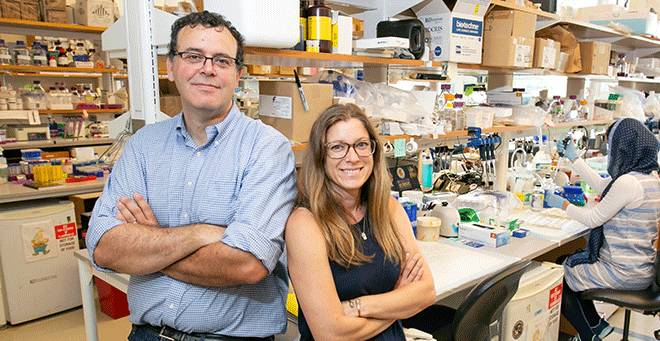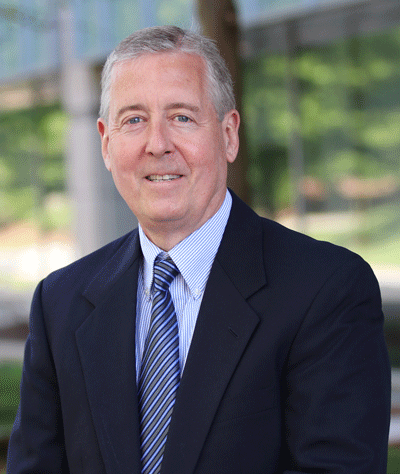Heather Gray-Edwards, Miguel Sena-Esteves and Raymond Dunn are recipients of 2021 awards

The Office of Business Development & Innovation at UMass Medical School has announced the 2021 BRIDGE Fund grants, which support innovative scientific advances at the Medical School.
The fund is administered by Parth Chakrabarti, MBA, executive vice chancellor for innovation and business development, and managed by Abbas Abdallah, PhD, technical business development manager. It is expected that BRIDGE Fund awards will make possible critical research that will expedite the advancement of discoveries and technological advances into potentially viable commercial products for diagnosing and treating human diseases. The BRIDGE Fund is guided by an external advisory board of industry leaders and will invest up to $1 million annually in projects by UMass Medical School researchers whose work shows promise for commercialization and translation to a clinical application.
Awardees this year are Heather Gray-Edwards, PhD, DVM, assistant professor of radiology, and Miguel Sena-Esteves, PhD, associate professor of neurology, for their proposal, “Gene Therapy for Sialidosis;” and Raymond Dunn, MD, professor of surgery, his proposal, “Prevention of Pressure Ulcers: A Wireless Pressure Sensor System to Transform Best Practices.”
Each project was awarded $250,000 over two years.
Sialidosis is a rare, fatal neurodegenerative disease caused by deficiency of the sialic acid-cleaving enzyme neuraminidase 1 (Neu1), which causes a buildup of sialylated glycopeptides and oligosaccharides in tissues and body fluids. Sialidosis type 1 has onset clinical signs in the teens and 20s, including difficulty walking that progresses to loss of ambulation; decreased visual acuity that progresses to blindness; involuntary movements of arms and legs (myoclonus); nystagmus; seizures; and hyperreflexia. It is fatal in the third to fifth decade of life. Type 2 is fatal in childhood, and children develop the myoclonus and seizures like the type 1 patients described above, but also develop developmental delay, milestone loss, intellectual disability, and hearing and vision loss.
There is no cure or treatment for this disease. The project will test AAV vectors that encode for Neu1 expression in animal models to restore Neu1 expression and normal function. Dr. Gray-Edwards and Dr. Esteves have previously brought AAV gene therapies to clinical trials, including a Tay-Sachs/Sandhoff clinical trial.

Pressure ulcers are one of the most medically and financially burdensome hospital-acquired complications in elderly, debilitated and spinal cord injured populations. Excessive pressure on patients’ skin leads to lack of blood supply (ischemia), commonly resulting in painful, difficult to treat wounds, ultimately leading to physical and psychological impairment. In the U.S., 2.5 million patients a year develop PUs, resulting in an estimated 60,000 deaths annually.
Current prevention of pressure ulcers is primarily based on empirical, nonpatient centered and inefficient strategies that rely on care providers to mobilize patients every few hours, regardless of whether a patient’s condition warrants it. The proposal by Dr. Dunn would develop wearable, integrated, remotely communicating patches containing sensors that monitor body areas with known risk of pressure ulcer development. The system detects early biological processes that lead to skin damage, then remotely communicates with caretakers in real-time for timely and targeted intervention. A device prototype has already been created and needs a few improvements to bring the technology to a stage ready for clinical adoption and licensing.
“UMass Medical School is home to a thriving biomedical research community that attracts nearly $300 million each year in external funding and has earned a global reputation for excellence,” said Chancellor Michael F. Collins. “We have noted an increased demand from the life sciences sector to partner with our faculty to advance promising discoveries and are pleased that the BRIDGE Fund will help us meet that goal in an ongoing, meaningful way.”
Chakrabarti praised the work of the faculty members who made proposals for BRIDGE funding. “The research community at UMass Medical School has incredibly diverse experience and a thirst for innovation; ideas such as these will continue to help the medical school fast-track discoveries that can improve the health and well-being of people everywhere.”